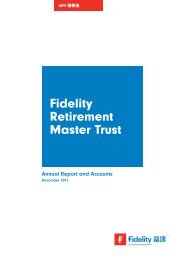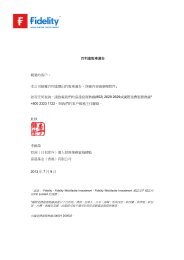SKANDIA GLOBAL FUNDS PLC - Fidelity Investments
SKANDIA GLOBAL FUNDS PLC - Fidelity Investments
SKANDIA GLOBAL FUNDS PLC - Fidelity Investments
You also want an ePaper? Increase the reach of your titles
YUMPU automatically turns print PDFs into web optimized ePapers that Google loves.
Skandia Global Funds plc<br />
Annual Report and Audited Financial Statements for the year ended 31 December 2011<br />
<strong>SKANDIA</strong> INVESTMENT GRADE CORPORATE BOND FUND<br />
INVESTMENT ADVISER’S REPORT FOR THE YEAR ENDED 31 December 2011<br />
Skandia Investment Grade Corporate Bond Fund – Wellington Management Company, LLP<br />
Below is a report from the Investment Adviser of the Skandia Investment Grade Corporate Bond Fund for 2011.<br />
The Skandia Investment Grade Corporate Bond Fund was launched on 19 March 2010 with a starting Net Asset Value per share<br />
of USD 10.00.<br />
Investment Adviser’s Commentary<br />
The Skandia Investment Grade Corporate Bond Fund underperformed its primary benchmark, the Barclays Capital Global<br />
Aggregate Corporate Bond Index. The fund recorded a total net return of 1.87%, while the benchmark index had a total return of<br />
4.79% for the period.*<br />
During the first quarter, corporate security selection was the primary driver of excess returns in the first quarter, with positioning in<br />
the three industry sectors, financials, industrials and utilities, contributing positively to results.<br />
Within financials, the allocation to banking securities contributed to excess returns as the fund‟s holdings of Lower Tier 2 securities<br />
benefited from limited supply and the expectation that holders of European bank debt would avoid haircuts or other forms of burden<br />
sharing. The fund‟s holdings of strategic, high-quality banks including Bank of America, Citigroup, BPCE and Danske Bank also<br />
performed well on the back of solid earnings and favourable regulatory developments. Security selection in finance companies was<br />
also positive, with the positions in Sallie Mae and GE Capital being the chief contributors. Underweight positions in Insurance were<br />
a modest detractor during the quarter.<br />
Within Industrials, the overweight positions in consumer non-cyclicals and capital goods outperformed during the period due to<br />
improving corporate fundaments and continued positive economic data releases, particularly in the US and Germany. Specifically,<br />
holdings within the tobacco and cement sectors contributed positively. Security selection in Communications detracted as many of<br />
the recent top-performing media-cable and telecommunications names, such as Time Warner Cable, British Telecom, DirecTV<br />
Holdings and News Corp, in which the fund held overweight positions, lagged the broader market.<br />
Utilities were a key sector for positive performance, particularly in March, as Electric issuers sold off significantly after the<br />
devastating earthquake and ensuing nuclear crises in Japan. The fund did not own Tokyo Electric Power, which operates the stricken<br />
Fukushima Daiichi nuclear power plant and one of the largest issuers in the Japanese corporate bond market. These gains were<br />
partially offset by adverse security selection in the natural gas sector.<br />
In a reversal of last year‟s trend, the fund‟s overweight to US Dollar-denominated versus Euro- and Sterling-denominated corporate<br />
bonds detracted, as US corporate bond markets lagged. Underweight positions in corporate issuers domiciled in Greece, Ireland,<br />
Italy, Portugal and Spain also detracted value as these markets rebounded in anticipation of announcements from the EU which<br />
should ease funding pressures on European governments and corporates alike.<br />
Within sector allocation, the fund‟s holdings of government-related securities detracted, although the short positions in Sovereign<br />
bonds in favour of corporate issuers contributed positively to performance as corporate credit continued to outperform governments.<br />
The fund‟s holdings of securitized debt had a positive impact on excess returns, mainly driven by the overweight position in<br />
commercial mortgage-backed securities (CMBS).<br />
Gains generated through duration management were more than offset by losses from yield curve positioning. The overweight<br />
duration position in January added value as US and European government bond yields fell as oil prices spiked following the<br />
escalation of tensions in the Middle East and North Africa. However, the fund‟s yield curve positioning, particularly in the US,<br />
detracted as long-dated treasuries sold off. The German bund versus Italian government bond position also detracted as European<br />
sovereign credit concerns eased.<br />
The Skandia Investment Grade Corporate Bond Fund underperformed its primary benchmark, the Barclays Capital Global<br />
Aggregate Corporate Index (hedged to US Dollars), for the second calendar quarter of 2011.<br />
62

















